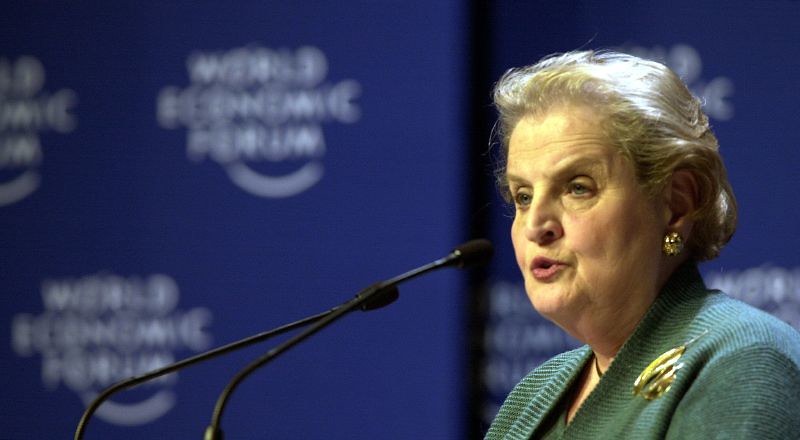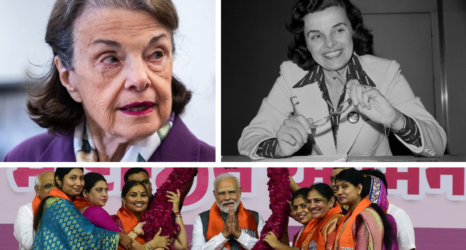“Women’s rights are human rights” still reverberates around the world as it did in Beijing 25 years ago. Yet gender equality has not been reached in any country, though it is both a moral imperative and smart policy.

This article originally appeared on PassBlue. It has been republished with permission.
Twenty-five years ago, tens of thousands of women (and some men) gathered in Beijing for the United Nations Fourth World Conference on Women. It was a profound moment in the history of women’s rights, convening 5,000 official delegates from nearly every country in the world and more than 30,000 activists at a parallel forum for nongovernmental organizations in Huairou. There, 189 countries signed on to a Declaration and Platform of Action that laid out an ambitious vision and concrete steps for achieving equality. That blueprint continues to shape the struggle for women’s equality.
Participants in the conference and NGO forum, including more than 8,000 Americans, pledged to “Bring Beijing Home,” taking new networks and innovative ideas back to their own countries. The conference spurred global progress on a range of issues, from closing the gap on girls’ education to new laws to combat violence against women. It also greatly influenced and, in many ways, fundamentally reshaped American foreign policy.
In preparing for Beijing and to implement the Platform for Action, the Clinton administration elevated the issue of global women’s rights across United States foreign policy, development and security agendas. The policies and programs they introduced formed the foundation of the current policy architecture on global women’s rights.
Preparing a Platform
Preparation for American participation at the Beijing conference began a year earlier, in 1994. A Global Conference Secretariat, housed at the State Department under Secretary of State for Global Affairs Tim Wirth, working in tandem with the White House first lady’s office, was responsible for shaping the US negotiating platform. Secretariat staff contacted government agencies asking for information about how they were advancing the status of women and girls. For many offices, this request was the first time they had ever been approached about their programs on this issue.
The Secretariat also hosted a series of meetings to gain the public’s views on the Beijing platform. Together, these efforts began to socialize the idea that gender equality was an administration policy priority to the executive branch agencies and to the American public—a priority that was clearly demonstrated by the diverse and high-level members of the official U.S. conference delegation.
The U.S. ambassador to the UN at the time, Madeleine Albright, was appointed to head the delegation, which included Donna Shalala, the head of Health and Human Services; the former New Jersey Republican Governor Tom Kean; Geraldine Ferraro; and less well-known women — a Muslim physician, a Catholic nun, an Hispanic legislator from Florida, a Republican journalist and a Black civil rights lawyer, among others — who represented the face of America at the Beijing gathering.

Symbolic Leadership
A defining moment of the conference was the electrifying speech given by First Lady Hillary Clinton—who had been invited by the UN secretary-general, Boutros Boutros-Ghali—denouncing a litany of violations of women’s rights, including in the host country, China. Her refrain, “women’s rights are human rights,” became a rallying cry and brought a slogan coined by women human-rights activists onto the world stage as her speech generated widespread coverage across the globe.

In the U.S., editorial political opposites—The New York Times and The Washington Times—both applauded her strong expression of American values.
In her study of foreign policy during the Clinton administration, Prof. Karen Garner at SUNY Empire State College, writes that Clinton’s speech “transformed government policy language,” especially at the highest levels. A year later, Albright, who became the first woman secretary of state, proclaimed:
“Advancing the status of women is not only a moral imperative; it is being actively integrated into the foreign policy of the United States. It is our mission.”
Women had long been advocating for their concerns to be recognized as fundamental human-rights issues, but even in advocacy organizations like Amnesty International and Human Rights Watch, women’s rights were a marginal special interest at the time. The UN conference not only confirmed women’s rights in international human-rights law, but Clinton’s speech gave considerable credibility to women’s human-rights advocates in their own organizations and in the U.S. government.
According to Theresa Loar, the director of the State Department’s Global Conference Secretariat during and after the Beijing conference, these advocates began to receive “invitations to White House policy events and calls to provide input into foreign policy and development assistance policies.” The first lady’s office, working with the National Security Council and the State Department, became the hub for promoting “women’s rights as human rights.”
Creating Institutions
Beyond rhetorical changes, the conference sparked new formal programs and offices tasked to carry out its goals. President Bill Clinton announced the creation of an Interagency Council on Women on Aug. 26, 1995—the 75th anniversary of women’s suffrage, and just days before the U.S. delegation embarked for Beijing. The Council, a high-level leaders’ initiative in cabinet agencies, was set up to incorporate the conference’s Platform for Action; or as President Clinton said, “Make sure that all the effort and good ideas actually get implemented when we get back home.”
Albright served as the first chair of the council and Hillary Clinton as the honorary chair.
The two women forged a strong partnership to empower women globally. Two months after Albright was sworn in as secretary of state, on International Women’s Day, they both spoke at the State Department on the importance of the “seamless inclusion of girls’ and women’s needs in American foreign policy.”
This past September, Clinton and Albright reunited for a virtual event, reflecting on how the Beijing conference shaped their work together. As Clinton reflected, “Secretary Albright made it clear that the agenda coming out of Beijing was not just a luxury that would be nice to think about when we had time, but actually integrated.”
Albright described their respective offices as a “tag team” advancing the visibility of women’s and girls’ rights, and she put the advancement of women’s human rights in the forefront of US foreign policy. Embassies were instructed to include women’s issues in their standard reporting; human-rights reports were now to include abuses of women in country assessments; the work of the office of international women’s issues was elevated to coordinate policy on issues of concern to women, including those outlined in the Beijing Platform for Action.
The office became the precursor to the Office of Global Women’s Issues, which was elevated during the Obama administration and headed by the first-ever US Ambassador of Global Women’s Issues, reporting directly to the secretary of state and continues today.
Hillary Clinton traveled the world, meeting with women at both the leadership and grass-roots levels in more than 50 countries that she visited after the Beijing conference and calling international attention to their issues. The Vital Voices Global Democracy Initiative was launched, led by the first lady, working in concert with embassies to promote women’s full participation in the political, social and economic lives of their countries.
In Northern Ireland, she brought together women from both the Catholic and Protestant traditions who, after decades of bloodshed, wanted to work collectively for a new, peaceful future. She met with women during the wars in Bosnia and Kosovo and Rwandan women struggling to survive after the genocide, promoting the role of women in peace, recovery and security.
Both the State Department and the White House condemned the treatment of women in Afghanistan by the Taliban and funding was increased for health and education for Afghan women and girls in refugee camps in Pakistan. Today, their progress, as the intra-Afghan peace talks begin, remains critical to Afghanistan’s peace and security.
The Beijing Platform called for the participation of women in conflict resolution and the protection of women living in armed conflict. The State Department and USAID researched the role of women in post-conflict societies and invested in women’s initiatives in post-conflict societies that the first lady had visited.
In 2000 at Beijing+5 events at the UN, Albright signed on to a UN framework through Resolution 1325, building on the Beijing Platform and recognizing the role women play in peace and security.
That framework remains foundational to U.S. foreign and security policy. In 2011, the U.S. adopted a National Action Plan on Women, Peace and Security when President Obama signed an executive order, and in 2017, the bipartisan Women, Peace and Security Act was adopted into law in the U.S.—the first such law in the world. It has already affected the diplomatic, development and military engagement of the US in peace-building work from Afghanistan to Sudan to Colombia.
The first lady also spotlighted U.S. development assistance through USAID and demonstrated through her advocacy and travels how small investments in foreign assistance for health care, girls’ education, economic empowerment and ending violence against women can make a difference globally.
In its five-year report after the Beijing conference, USAID noted a range of new and increased investments in women and girls across the development sectors—democracy and governance, economic growth and development and health and nutrition, among others—directed to helping women overcome economic and social barriers that prevented their equal participation in society. Major new programs were launched in girls’ and women’s education and micro-enterprise development.
The next year, USAID formally adopted “gender mainstreaming” in its operations to ensure that a gender perspective is part of all programming.
Today, USAID leads an expansive gender equality and women’s empowerment program that is integrated across the agency’s work.
It was during her travels that the first lady learned about human trafficking from women in the former Soviet Union. These conversations resulted in the creation of an interagency effort headed by the White House, in collaboration with Congressional partners, to protect the victims of human trafficking and ensure the prosecution of the perpetrators of modern-day slavery. The Trafficking Victims Protection Act became law at the end of the Clinton administration, the first national law to tackle human trafficking and establish the prevention, protection and prosecution framework that still guides US antitrafficking work.
In “America’s Commitment,” the report published in 2000, the Interagency Council reviewed how US actions stacked up against the Beijing Platform’s 12 areas of concern. Many of the achievements focused on domestic issues—improving working conditions for women, equalizing access to government services, investing in research on women’s health—but some of the most dramatic concerned foreign policy and development aid.
Today, we have extensive research and data that show the condition of women and the condition of nations go hand in hand. Women’s economic participation grows economies and inclusive prosperity, and their engagement in peace negotiations and peace-building sustains peace, stability and security. Women’s political participation brings important issues to public policy. Societies that uphold women’s rights are more peaceful and prosperous.
“Women’s rights are human rights” still reverberates around the world as it did in Beijing 25 years ago. Yet gender equality has not been reached in any country, though it is both a moral imperative and smart policy. The changes implemented in U.S. development, diplomacy and defense after Beijing created important architecture and policy initiatives, but progress must be accelerated.
Achieving the goals set out in the Beijing Platform for Action requires political will and a renewed commitment to placing gender equality at the center of American foreign policy.
You may also like:





